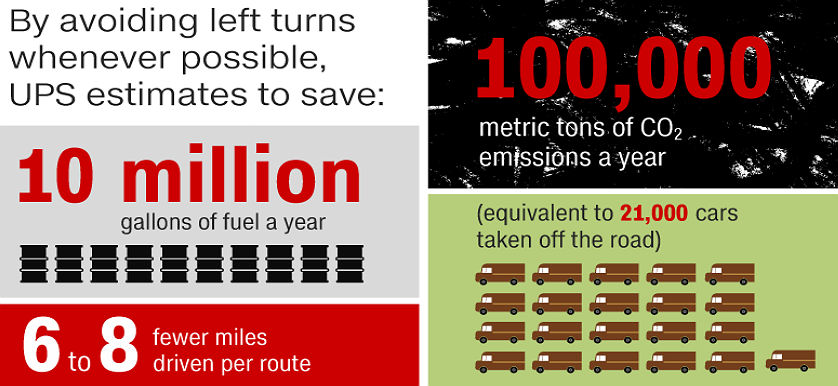UPS trucks almost never take left-hand turns.
They have designed their vehicle routing software to eliminate as many left-hand turns as possible (in countries with right-hand traffic).
Left-turning traffic typically has to turn against a flow of oncoming vehicles. This can not only be dangerous, but makes traffic build up.
By insisting drivers take right-hand turns at all times -- unless a left is unavoidable -- the company claims it uses 10m gallons less fuel, emits less carbon dioxide and delivers 350,000 more packages every year. The efficiency of planning their routes with its navigation software this way has even helped the firm cut the number of trucks it uses.
The practice started decades before computers and GPS, and is now managed by software that automates the most efficient route for each truck.
It’s a great example of thinking differently, and using real time data and logistics to deliver real value to customers and employees.
Yesterday we took part in a session with Jonny and Shaun from our technology partners Microsoft, who are helping us do the same - reimagine how our field services will operate in the future.
Microsoft Dynamics 365 for Field Service helps organisations deliver onsite service to customer locations. The application combines workflow automation, scheduling algorithms, and mobility to set mobile workers up for success when they're onsite with customers fixing issues.
What we don’t want to do as part of our transformation programme is just make what we already have just a little bit slicker. We want to build a platform to make Bromford future ready.
So yesterday made us think:
How can we boost collaboration across all our mobile teams - ensuring we design services as one organisation not a series of disconnected silos?
How can we take advantage of the number of people we have working out in neighbourhoods, the coaches, engineers, sales colleagues, surveyors who have most contact with our customers? Bromford is now a truly mobile, community focused business.
How do we ensure we are not constrained by the way we’ve done things traditionally - how would UPS or Amazon run our business given the resources we have? How would they deploy neighbourhood coaching?
Yesterday was very much about showing us what’s possible.
Now we have to map out what we want in line with our design principles.
We’ll let you know how we get on.

